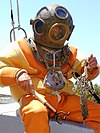Pulmonary circulation
This article needs additional citations for verification. (April 2011) |

Pulmonary circulation is the half portion of the cardiovascular system which carries oxygen-depleted blood away from the heart, to the lungs, and returns oxygenated (oxygen-rich) blood back to the heart. The term pulmonary circulation is readily paired and contrasted with the systemic circulation. A separate system known as the bronchial circulation supplies blood to the tissue of the larger airways of the lung.
Course
Pulmonary circulation is the movement of blood from the heart, to the lungs, and back to the heart again. De-oxygenated blood leaves the heart, goes to the breathing apparatus, which is the lungs, and then re-enters the heart; oxygen poor blood leaves through the right ventricle through the pulmonary artery, the only artery in the body that carries oxygen-poor blood, to the capillaries where carbon dioxide diffuses out of the blood cell into the alveoli, and oxygen diffuses out of the alveoli into the blood. Blood leaves the capillaries to the pulmonary vein, the only vein in the body that carries oxygen-rich blood in the body, to the heart, where it re-enters at the left atrium.
Right heart
Oxygen-depleted blood from the body leaves the systemic circulation when it enters the right heart, more specifically the right atrium through the superior (upper) vena cava and inferior (lower) vena cava. The blood is then pumped through the tricuspid valve (or right atrioventricular valve), into the right ventricle. Blood is then pumped through the semilunar valve and into the pulmonary artery.
Arteries
From the right ventricle, blood is pumped through the pulmonary semilunar valve into the left and right pulmonary arteries (one for each lung) and travels through the lungs.
Lungs
The pulmonary arteries carry deoxygenated blood to the lungs, where it releases carbon dioxide and pick up oxygen during respiration. Arteries are further divided in to very fine branches called the capillaries. In structure the capillaries are very thin walled. Their function is to carry blood to all cells of the body.
Veins
The oxygenated blood then leaves the lungs through pulmonary veins, which return it to the left heart, completing the pulmonary cycle. This blood then enters the left atrium, which pumps it through the bicuspid valve, also called the mitral or left atrioventricular valve, into the left ventricle. The blood is then distributed to the body through the systemic circulation before returning again to the pulmonary circulation.
History
According to R.A. Young, "Wiberg suggests that the early Greeks knew of the circulation, and quotes a passage from one of the Hippocratic writings which would bear that interpretation."[1]
Pulmonary circulation was described by Ibn al-Nafis in his Commentary on Anatomy in Avicenna's Canon (1242). It was also described and published by Michael Servetus in Christianismi Restitutio (1553). Since it was a theology work condemned by most of the Christian factions of his time, the discovery remained mostly unknown until the dissections of William Harvey in 1616.
Embryonic
The pulmonary circulation loop is virtually bypassed in fetal circulation. The fetal lungs are collapsed, and blood passes from the right atrium directly into the left atrium through the foramen ovale, an open passage between the two atria. When the lungs expand at birth, the pulmonary pressure drops and blood is drawn from the right atrium into the right ventricle and through the pulmonary circuit. Over the course of several months, the foramen ovale closes, leaving a shallow depression known as the fossa ovalis in the adult heart.
See also
References
- ^ Young, R. A. (1940). "The Pulmonary Circulation--Before and After Harvey: Part I". BMJ. 1 (4122): 1. doi:10.1136/bmj.1.4122.1. PMC 2176288. PMID 20782884.

